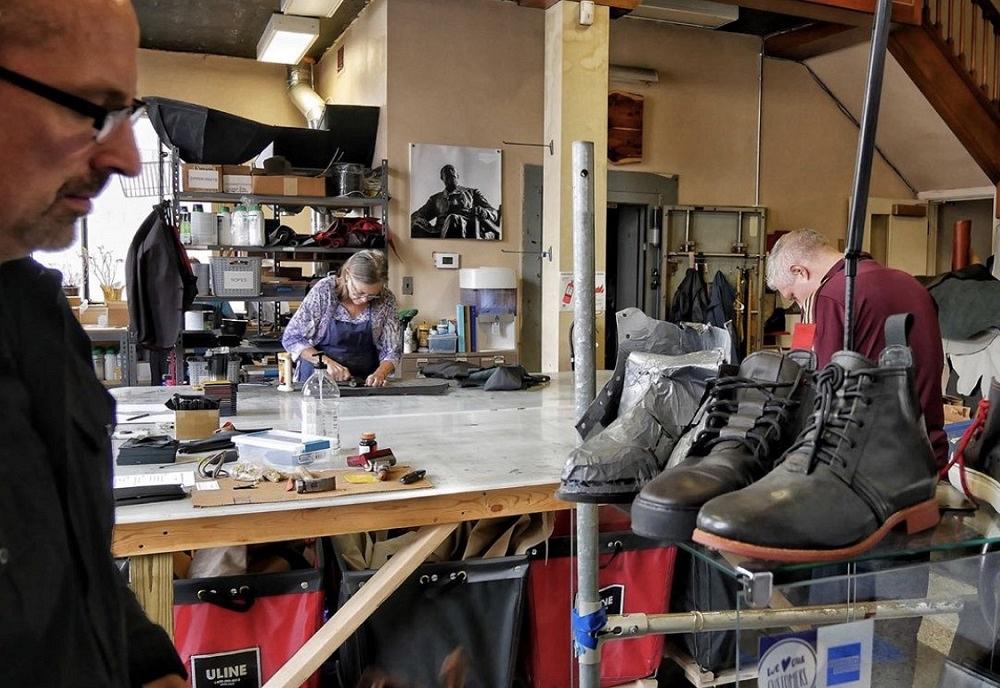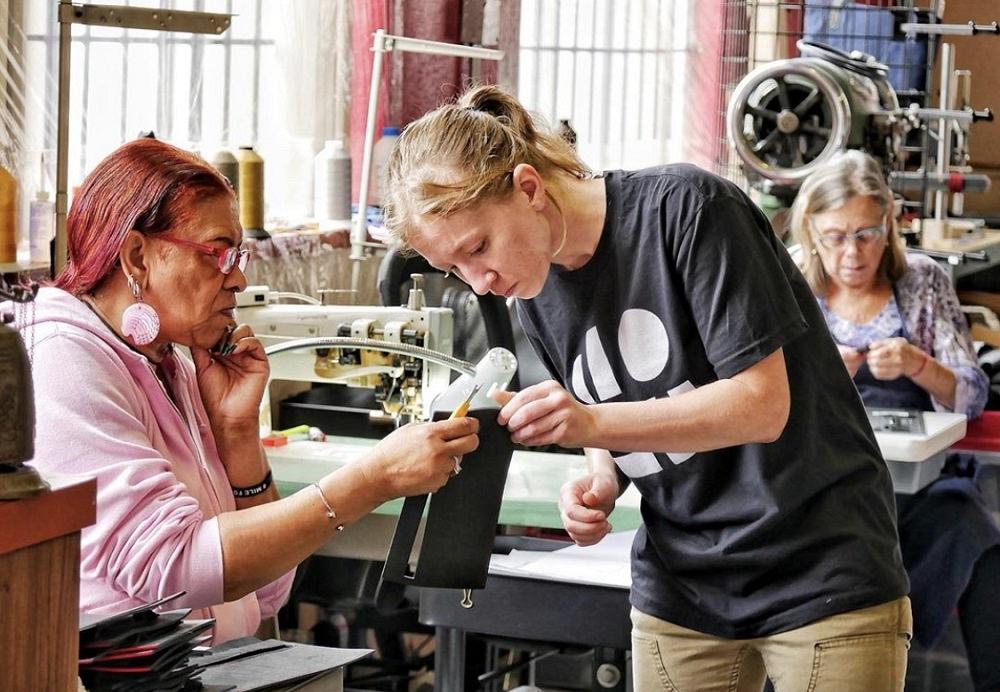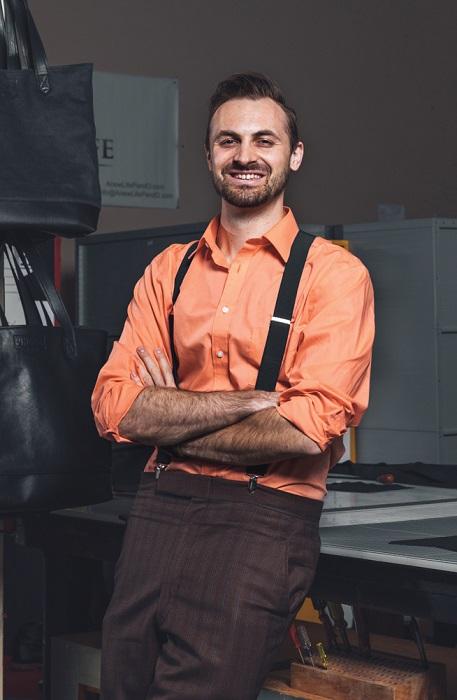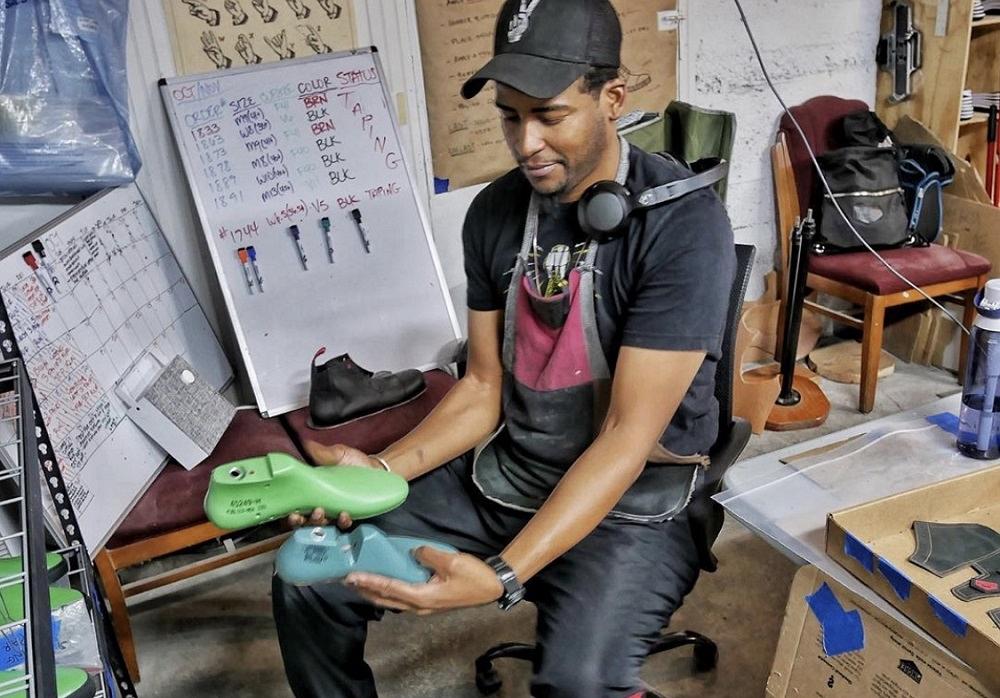- FMA
- The Fabricator
- FABTECH
- Canadian Metalworking
Categories
- Additive Manufacturing
- Aluminum Welding
- Arc Welding
- Assembly and Joining
- Automation and Robotics
- Bending and Forming
- Consumables
- Cutting and Weld Prep
- Electric Vehicles
- En Español
- Finishing
- Hydroforming
- Laser Cutting
- Laser Welding
- Machining
- Manufacturing Software
- Materials Handling
- Metals/Materials
- Oxyfuel Cutting
- Plasma Cutting
- Power Tools
- Punching and Other Holemaking
- Roll Forming
- Safety
- Sawing
- Shearing
- Shop Management
- Testing and Measuring
- Tube and Pipe Fabrication
- Tube and Pipe Production
- Waterjet Cutting
Industry Directory
Webcasts
Podcasts
FAB 40
Advertise
Subscribe
Account Login
Search
Still Building America: Manufacturer uses leather reclaimed from Detroit auto industry
Pingree Detroit works to empower local community, veteran workforce, and U.S. manufacturing
- By Darla Welton and Josh Welton
- December 22, 2019

Detroit leather goods manufacturer Pingree Detroit uses leather reclaimed from the Detroit auto industry while working to empower the local community, veteran workforce, and U.S. manufacturing. Pictured: Stephen Schock, co-owner and lead designer at Pingree Detroit; Mary Storey, designer and pattern maker; Army veteran Joseph Layde, footwear and accessory maker. Photos by Darla and Josh Welton
Riding my bike on a beautiful fall afternoon, I stopped at Detroit’s Eastern Market. Searching for coffee, I was quickly distracted by a striking display of fine leather goods at the Pingree Detroit booth. I can’t remember whether it was social media, a local shop, or a holiday pop-up that first brought their product to our attention, but Josh and I had been following the company for a while.
It just so happened that Jarret Schlaff, Pingree Detroit CEO, co-founder, and co-owner, was running the booth that day. I introduced myself and heard about how Pingree Detroit is uniquely serving their customers, their makers, and their local community with sustainability, empowering the local veteran workforce, and supporting U.S.-based manufacturing. There was something simultaneously old- school and new-school about these maker-fabricators and I had to learn more.
What Is Pingree Detroit?
On a corner of Woodward Avenue in Detroit stands a once abandoned bank building, now occupied by a prosthetics company and Pingree Detroit, a maker of handcrafted footwear, bags, and accessories created from high-quality leather reclaimed from the Detroit auto industry.
We visited the workshop on a Monday morning and were greeted by Stephen Schock, lead designer and co-owner. He handed us a business card displaying the slogan, “Smells like a new car because it nearly was.” We were in the right place.
Heart and Sole: How It All Got Started
In 2014 Jarret Schlaff realized that he shared a neighborhood with unemployed veterans who were driven and desired meaningful work with a living wage. Creating jobs was an obvious solution, but what could they make to actually create jobs? And what other problems could they address? Noting a lack of sustainable alternatives to everyday needs, Jarret determined he would make footwear.
Around the same time, College for Creative Studies Product Design Professor Stephen Schock was working with a local organization called Cass Community Social Services. As Stephen tells it, “They had a project called Green Industries where they would create products and hire homeless, formerly homeless, and developmentally disadvantaged people to run it. They were making things like mud mats out of tire treads and coasters out of recycled glass. I helped them create a production process for creating sandals out of tire tread. They manufactured those for a year or so, but it was tough to keep up quality control because of the turnover and learning curve so they phased out that program.
“However, that is how Jarret heard of me and thought, ‘This guy’s making sandals out of tire tread; maybe we can do something!’ So we sat down and had coffee, he shared his vision, and I thought that is something I’d like to be a part of! I teach full-time at CCS and I’m educating kids for the future, so that feels good, but I like to be involved in the community and to give back.”
Their first shoe prototype was made out of duct tape! Jarret took their humble prototype and pitched their idea at a local microgranting event, but it was not chosen. They also approached a large Michigan manufacturer and tried crowdfunding, but they didn’t sell enough to make a run. However, at the same time, the College for Creative Studies started a fashion accessories program in whichthe classes offered was bootmaking.
Stephen said, “Jarret and I took the bootmaking class. I’m a designer, so I could design things, but I couldn’t make them. Once we learned how to make shoes, we could make our own serious prototypes. We started to streamline manufacturing, reducing parts and time, and eventually developed the first Pingree boot manufacturing process. And we still tweak that process every day; there are always things we can improve on. But we are at a point where we are doing a good job. It still takes a day and a half to make a pair of shoes, from rolling out the leather to putting them in the box. Fifteen to 16 hours to make one pair of boots, but that’s what we wanted to do. We wanted handmade craftsmanship.”
So in 2015 Pingree Detroit was co-founded as “a worker-owned, social impact company” creating “living-wage work for veterans and Detroiters.” They currently have seven employees exercising and developing their trade and expertise.

From left: Rayne Rose, co-owner and lead accessory maker at Pingree Detroit, and Wendy Magee, production manager and maker.
On Mission: Veterans, Community, and Sustainability
1. Veterans and Detroiters:The first part of the Pingree mission is to employ as many veterans and Detroit citizens as possible. They also offer co-ownership along with a living wage. Their website states: “We are a worker owned company and create community rooted wealth by sharing 77% of profits our company makes with the veterans and Detroiters on our team. Every maker on our team has opportunities to learn skilled trades in shoe making, leather crafting, design, advanced manufacturing, and entrepreneurship.”
During our visit we met Nate Crawford, footwear-maker, co-owner, and U.S. Air Force veteran. “I’ve worked here about a year. A young lady over at CCS taught me and another veteran how to get the ball rolling. It came somewhat naturally because I used to draw, I am keen with detail, and patient. There are new challenges every day, but I love this. Learning a trade and really taking ownership, I’m making something that hasn’t been done since the 1950s in Detroit -- handcrafting shoes! Born and raised in the city, I always wanted to do something that involved the city and the community, so this is awesome. And someone is going to be wearing what I make!”
Nate is also a teacher now. He teaches bootmaking and does live demos at Detroit’s Eastern Market. Excitedly he told us, “We do workshops with the local veterans down the street at the Volunteers of America housing program. We train them on how to make wallets and keychains and use the tools that we have to imprint the leather. Then we buy the product back from them or they can keep it if they want; otherwise we sell those at Eastern Market.”
Detroit is certainly a maker mecca, and this team is carrying on that legacy.
2. Sustainability:The second part of the Pingree mission is sustainability: “All our processes are nontoxic. We upcycle leather and other materials otherwise destined for the landfill. The majority of our equipment and materials are sourced from the USA. All shipping materials we use are 100% recycled and compostable. Moving forward, by 2023 we are committed to: Designing products so that we can source the majority of materials from the Great Lakes region; create zero waste; have zero carbon emissions; and offer military-grade, fossil-free, plant-based alternatives to leather and plastic.”
Not only is the leather currently sourced from the Detroit automotive industry, but the contact cement is made in Texas, the red pull tabs are made in Louisiana, the eyelets are from Alabama, and the carbon fiber shoelaces are made in Brooklyn, Nate said These high-quality goods are 100% USA-sourced and -made.
Additionally, if your Pingree shoes or boots start wearing down, you can ship them back to Detroit and have them repaired.
Design and Manufacturing Process
“We design to solve problems,” said Stephen. “So with the shoe, how could we make it easier to put it on? How do we keep the tongue from moving around? How do we keep seams away from bones? Comfort, ease of putting it on, and holding things in place all went into our design. We do our R&D by wearing the stuff!”
From Jarret and Stephen’s duct tape prototype to the final shoe, their first Pingree design and manufacturing process took a year, with about 13 versions in between.
And that process was well worth it! It is iconic and highly identifiable as the Pingree Shoe.
The current design has a cup sole, which is like a cap that fits on the bottom of the shoe. The next-generation boot coming out will be a welted boot, which is a different construction method and more labor-intensive. It will have stitch-on leather or a composite sole with a heel, so it’s more of a dress boot with a higher price.
The products are useful and beautiful. “Each piece has character and purpose, just like the people who make it. Right here, in Detroit.” Nate Crawford likes to call the Beaubien Cross-Body Bag the “Coach-killer.”
And how about the name Pingree? “Hazen S. Pingree was a shoemaker, making a million pairs of shoes every year in Detroit in the 1930s. He was mayor of Detroit, the governor of Michigan, a social entrepreneur, an urban farmer, and most importantly he was a man of the people. He exposed a lot of corporate corruption. He was a moral man and a good role model. We are proud to have his name,” Stephen said.
And we couldn’t agree more. From who or what you name the company after to how you make or source your parts - it matters. We think Mayor Pingree would be proud too.
As for the future of Pingree, Stephen shared their vision of expanding the product line, experimenting with new materials such as hemp canvas, continuing to shape the manufacturing processes, and building up the workforce.
Follow Pingree Detroit on Instagram at @pingreedetroit.
subscribe now

The Fabricator is North America's leading magazine for the metal forming and fabricating industry. The magazine delivers the news, technical articles, and case histories that enable fabricators to do their jobs more efficiently. The Fabricator has served the industry since 1970.
start your free subscriptionAbout the Authors

Josh Welton
Owner, Brown Dog Welding
(586) 258-8255
- Stay connected from anywhere

Easily access valuable industry resources now with full access to the digital edition of The Fabricator.

Easily access valuable industry resources now with full access to the digital edition of The Welder.

Easily access valuable industry resources now with full access to the digital edition of The Tube and Pipe Journal.
- Podcasting
- Podcast:
- The Fabricator Podcast
- Published:
- 04/16/2024
- Running Time:
- 63:29
In this episode of The Fabricator Podcast, Caleb Chamberlain, co-founder and CEO of OSH Cut, discusses his company’s...
- Industry Events
16th Annual Safety Conference
- April 30 - May 1, 2024
- Elgin,
Pipe and Tube Conference
- May 21 - 22, 2024
- Omaha, NE
World-Class Roll Forming Workshop
- June 5 - 6, 2024
- Louisville, KY
Advanced Laser Application Workshop
- June 25 - 27, 2024
- Novi, MI


































